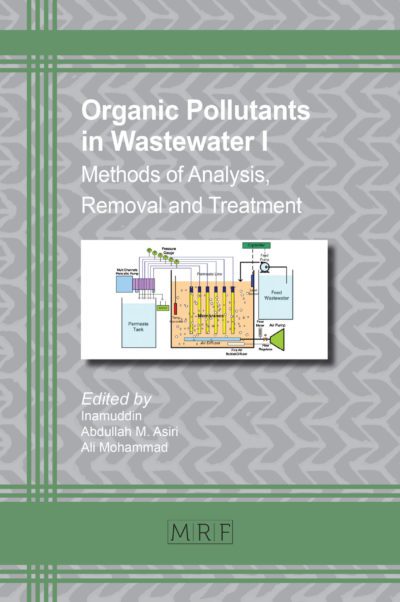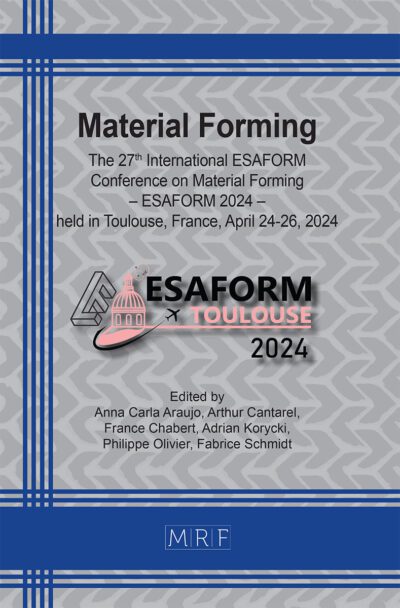Recycling magnesium alloy AZ31B chips via friction stir consolidation: A sustainable approach
Muhammad Adnan, Simone Amantia, Riccardo Puleo, Giuseppe Ingarao, Livan Fratini
Abstract. The growing demand for lightweight alloys has resulted in significant environmental challenges due to the exponential growth of machining waste, such as magnesium alloy chips. Conventional recycling techniques for these chips are often associated with oxidation losses, energy inefficiencies, and elevated greenhouse gas (GHG) emissions. Friction Stir Consolidation (FSC) emerges as a sustainable and solid-state recycling technique that mitigates these drawbacks by consolidating magnesium alloy chips directly into solid billets. This study investigates the FSC process applied to AZ31B magnesium chips, focusing on the influence of processing time on the quality of the consolidated billets. An experimental campaign was conducted with four distinct consolidation times, evaluating the mechanical properties and energy consumption of the process. Additionally, numerical simulation was performed to analyze the process mechanics. The results revealed that FSC successfully produced consolidated billets, with the highest consolidation level achieved at a process time of 60 seconds. Hardness analysis revealed a decreasing trend from the top to the bottom of the billet, with maximum values below those of the base material.
Keywords
FSC, Magnesium, Recycling, Environmental Impact, Solid State Technique
Published online 5/7/2025, 10 pages
Copyright © 2025 by the author(s)
Published under license by Materials Research Forum LLC., Millersville PA, USA
Citation: Muhammad Adnan, Simone Amantia, Riccardo Puleo, Giuseppe Ingarao, Livan Fratini, Recycling magnesium alloy AZ31B chips via friction stir consolidation: A sustainable approach, Materials Research Proceedings, Vol. 54, pp 2546-2555, 2025
DOI: https://doi.org/10.21741/9781644903599-275
The article was published as article 275 of the book Material Forming
![]() Content from this work may be used under the terms of the Creative Commons Attribution 3.0 license. Any further distribution of this work must maintain attribution to the author(s) and the title of the work, journal citation and DOI.
Content from this work may be used under the terms of the Creative Commons Attribution 3.0 license. Any further distribution of this work must maintain attribution to the author(s) and the title of the work, journal citation and DOI.
References
[1] E. G. Hertwich, “Increased carbon footprint of materials production driven by rise in investments,” Nature Geoscience 2021 14:3, vol. 14, no. 3, pp. 151–155, Feb. 2021. https://doi.org/10.1038/s41561-021-00690-8
[2] F. Jovane et al., “The incoming global technological and industrial revolution towards competitive sustainable manufacturing,” CIRP Annals, vol. 57, no. 2, pp. 641–659, Jan. 2008. https://doi.org/10.1016/J.CIRP.2008.09.010
[3] J. Du, W. Han, and Y. Peng, “Life cycle greenhouse gases, energy and cost assessment of automobiles using magnesium from Chinese Pidgeon process,” J Clean Prod, vol. 18, no. 2, pp. 112–119, Jan. 2010. https://doi.org/10.1016/J.JCLEPRO.2009.08.013
[4] Z. Cui et al., “Recent progresses, challenges and proposals on SF6 emission reduction approaches,” Science of The Total Environment, vol. 906, p. 167347, Jan. 2024. https://doi.org/10.1016/J.SCITOTENV.2023.167347
[5] E. Worrell, J. Allwood, and T. Gutowski, “The Role of Material Efficiency in Environmental Stewardship,” Annu Rev Environ Resour, vol. 41, pp. 575–598, Oct. 2016. https://doi.org/10.1146/annurev-environ-110615-085737
[6] J. Atherton, “Declaration by the Metals Industry on Recycling Principles,” Int J Life Cycle Assess, vol. 12, no. 1, pp. 59–60, 2007. https://doi.org/10.1065/lca2006.11.283
[7] L. F. Zhang and T. Dupont, “State of the Art in the Refining and Recycling of Magnesium,” Materials Science Forum, vol. 546–549, pp. 25–36, 2007. https://doi.org/10.4028/www.scientific.net/MSF.546-549.25
[8] T. Takenaka, S. Isazawa, Y. Kamo, M. Mishina, and M. Kawakami, “Electrorefining of Mg in Molten Salt,” Materials Science Forum – MATER SCI FORUM, vol. 419–422, pp. 653–658, Mar. 2003. https://doi.org/10.4028/www.scientific.net/MSF.419-422.653
[9] T. Zhu, N. Li, X. Mei, A. Yu, and S. Shang, “Innovative Vacuum Distillation for Magnesium Recycling,” in Magnesium Technology 2001, 2001, pp. 55–60. doi: https://doi.org/10.1002/9781118805497.ch12
[10] D. Paraskevas, S. Dadbakhsh, J. Vleugels, K. Vanmeensel, W. Dewulf, and J. R. Duflou, “Solid state recycling of pure Mg and AZ31 Mg machining chips via spark plasma sintering,” Mater Des, vol. 109, pp. 520–529, Nov. 2016. https://doi.org/10.1016/J.MATDES.2016.07.082
[11] Y. Pei, H. Ma, M. Yuan, and B. Teng, “Solid state recycling of Mg–Gd–Y–Zn–Zr alloy chips by isothermal sintering and equal channel angular pressing,” Journal of Magnesium and Alloys, vol. 12, no. 7, pp. 2725–2740, Jul. 2024. https://doi.org/10.1016/J.JMA.2022.11.007
[12] T. Peng, Q. D. Wang, and J. B. Lin, “Microstructure and mechanical properties of Mg–10Gd–2Y–0.5Zr alloy recycled by cyclic extrusion compression,” Materials Science and Engineering: A, vol. 516, no. 1–2, pp. 23–30, Aug. 2009. https://doi.org/10.1016/J.MSEA.2009.04.024
[13] D. Baffari, G. Buffa, D. Campanella, L. Fratini, and A. P. Reynolds, “Process mechanics in Friction Stir Extrusion of magnesium alloys chips through experiments and numerical simulation,” J Manuf Process, vol. 29, pp. 41–49, Oct. 2017. https://doi.org/10.1016/J.JMAPRO.2017.07.010
[14] D. Baffari, G. Buffa, and L. Fratini, “A numerical model for Wire integrity prediction in Friction Stir Extrusion of magnesium alloys,” J Mater Process Technol, vol. 247, pp. 1–10, Sep. 2017. https://doi.org/10.1016/J.JMATPROTEC.2017.04.007
[15] S. Amantia, D. Campanella, R. Puleo, G. Buffa, and L. Fratini, “Effect of process parameters on the mechanical properties of wires produced from A356 aluminum alloy chips by Continuous Friction Stir Extrusion: Experiments and numerical simulation,” CIRP J Manuf Sci Technol, vol. 54, pp. 28–42, 2024. https://doi.org/10.1016/j.cirpj.2024.08.001
[16] A. Latif, G. Ingarao, M. Gucciardi, and L. Fratini, “A novel approach to enhance mechanical properties during recycling of aluminum alloy scrap through friction stir consolidation,” International Journal of Advanced Manufacturing Technology, vol. 119, no. 3–4, pp. 1989–2005, 2022. https://doi.org/10.1007/s00170-021-08346-y
[17] M. Castro, P. H. Pereira, R. Figueiredo, and T. Langdon, “Developing magnesium-based composites through high-pressure torsion,” Letters on Materials, vol. 9, Dec. 2019. https://doi.org/10.22226/2410-3535-2019-4-541-545
[18] R. Abdi Behnagh, N. Shen, M. A. Ansari, M. Narvan, M. K. B. Givi, and H. Ding, “Experimental Analysis and Microstructure Modeling of Friction Stir Extrusion of Magnesium Chips,” J Manuf Sci Eng, vol. 138, Jan. 2015
[19] O. M. Shima S, “Plasticity theory for porous metals,” Int J Mech Sci, vol. 18, pp. 286–291, 1976
[20] A. Latif, G. Ingarao, and L. Fratini, “Multi-material based functionally graded billets manufacturing through friction stir consolidation of aluminium alloys chips,” CIRP Annals, vol. 71, no. 1, pp. 261–264, Jan. 2022. https://doi.org/10.1016/j.cirp.2022.03.035
[21] A. Latif, G. Ingarao, L. Fratini, P. Hetz, and M. Merklein, “Characterization of friction stir consolidated recycled billet by uniaxial compression tests with miniaturized cylindrical specimen,” in Materials Research Proceedings, Association of American Publishers, 2023, pp. 1997–2004. doi: 10.21741/9781644902479-215
[22] H. E. Friedrich, S. Schmid, E. Friedrich, and S. Ehrenberger, “Title Life Cycle Assessment of Magnesium Components in Vehicle Construction,” 2013
[23] Ehrenberger and Simone, “Carbon Footprint of Magnesium Production and its Use in Transport Applications Update of the IMA Report ‘Life Cycle Assessment of Magnesium Components in Vehicle Construction (2013),’” 2020
[24] D. R. Cooper, J. Song, and R. Gerard, “Metal recovery during melting of extruded machining chips,” J Clean Prod, vol. 200, pp. 282–292, Nov. 2018. https://doi.org/10.1016/J.JCLEPRO.2018.07.246.
[25] “Granta Design Limited 2023.” Accessed: Jan. 04, 2025. [Online]. Available: https://www.ansys.com/it-it/products/materials/granta-edupack
[26] R. Puleo, A. Latif, G. Ingarao, and L. Fratini, “A generalized parametric model for the bonding occurrence prediction in friction stir consolidation of aluminum alloys chips,” J Manuf Process, vol. 131, pp. 604–618, Dec. 2024. https://doi.org/10.1016/j.jmapro.2024.09.049














